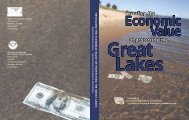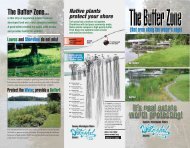Slope Stabilization Work Plan For Poplar River Management Board
Slope Stabilization Work Plan For Poplar River Management Board
Slope Stabilization Work Plan For Poplar River Management Board
Create successful ePaper yourself
Turn your PDF publications into a flip-book with our unique Google optimized e-Paper software.
<strong>Slope</strong> <strong>Stabilization</strong> <strong>Work</strong> <strong>Plan</strong><br />
North American Wetland Engineering, LLC.<br />
January 18, 2007 4444 Centerville Rd, Suite 140<br />
<strong>Poplar</strong> <strong>River</strong> <strong>Management</strong> <strong>Board</strong> White Bear Lake, MN 55127<br />
Phone: 651-255-5050<br />
Fax: 651-255-5060<br />
Section 5 - Megaslump Correction Options<br />
The megaslump is a major source of sediment to the <strong>Poplar</strong> <strong>River</strong>. Therefore corrective action is<br />
warranted. Several potential causes of the megaslump have been identified in Section 4 of this<br />
report including:<br />
1. Rotational Slump<br />
2. Streambank Erosion<br />
3. Surface Runoff<br />
4. Subsurface Saturation<br />
5. Wastewater Outfall<br />
6. Natural Slumping<br />
Each of these causes may have different corrective actions that may be necessary. This section<br />
outlines several corrective actions or Best <strong>Management</strong> Practices (BMP) options. Section 6 of<br />
this report will make recommendations for this project.<br />
5.1 Stream Diversion<br />
One method of reducing the height of the river and sediment transport from the megaslump<br />
would be to divert all or a part of the <strong>Poplar</strong> <strong>River</strong> away from the megaslump area. This would<br />
involve straightening the channel and preventing streamflow from contacting the unprotected<br />
portions of the slump area. The megaslump will continue to slump, however, if the river does<br />
not rise high enough to reach the unprotected base of the slump, the sediment would not be<br />
carried away creating more slumping. The megaslump area would establish a stable slope and<br />
revegetate naturally. Figure 5.1 shows approximately where the new channel would be located.<br />
The existing channel would have to be blocked or dammed to prevent the channel from<br />
reestablishing in this area. A new channel would have to be constructed and armored to prevent<br />
excessive erosion of the new channel.<br />
There are a number of difficulties with this approach. The terrain in this area is relatively flat<br />
and open and the area that would be used for the diversion is currently used as a maintenance and<br />
staging area for the equipment for the ski hill.<br />
Another concern about this approach is that further changes to the river’s characteristics may<br />
cause other erosion problems at other areas in the watershed. <strong>River</strong> straightening has historically<br />
caused problems in other parts of the river system. Long term effects of such activities are not<br />
well understood.







